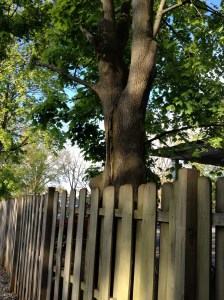Being invisible, the wind is easily forgotten. Until it begins to really blow. I don’t know about where you are, but this past week was a very windy one around here. Thursday especially. My office has a couple of windows and each view shows different kinds of trees. The south window reveals only a stolid oak or maple in a neighboring back yard a few doors down. I don’t know this neighbor and I’ve never been close enough to get a good look at his deciduous tree. Its leaves are down, of course, and although its branches moved in Thursday’s gusts there was never really a question of it coming down. Trunk stout and sturdy, it has stood through many windstorms and will likely see many more.
My west window opens to some lofty pines across the street. At least sixty feet tall, their trunks, like many coniferous species, stand fairly straight. The way these trees bent in the wind worried me as a home owner. And as a human being. You see, I have done some woodwork. A guy with as many books as we have either runs himself broke on buying bookshelves or learns to make his own. I’ve spent plenty of my money on one-inch pine boards—the standard shelving material. The 1 x 10, which is really 3/4 of an inch by 9 and 3/4, is the usual bookshelf board. Not even an inch thick, it isn’t easily bent. Incorporated into the trunk of a tree, it’s absolutely immobile if I press against it. I’ve tried to move a mature tree trunk. Even a good-size branch. Mere humans can’t. And yet I see these very same trunks swaying like they’re waltzing with the wind.
No wonder the weather has always been associated with the gods. I mean, on Thursday last I saw these giants in the earth bending in arborescent obeisance. The wind is easily forgotten. As I worked on Weathering the Psalms, I easily sketched out the chapters on rain, lightning, and even snow. But wind. If you exegete a storm often the most damaging aspect is the wind. Hurricanes and tornadoes damage due to their great wind velocity (the former also from impressive rain dumps). What we call EF5 (or F5) tornadoes are so violent that any instrument directly in their path can’t survive its onslaught. Winds swirling over 300 miles per hour are pretty much incomprehensible. And yet when they dissipate, those violent winds are once again invisible. Isn’t that just like the gods?


Pingback: The Wind and Trees — Steve A. Wiggins | Talmidimblogging